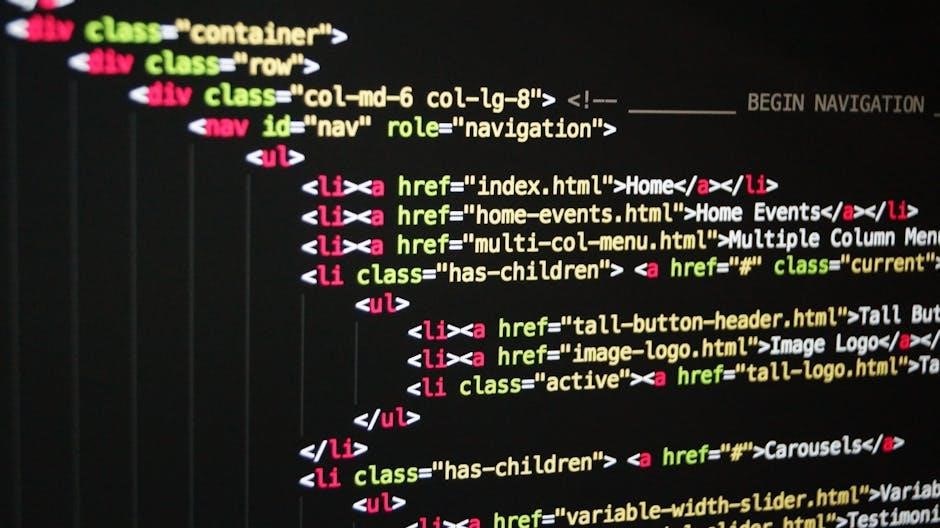Fanuc M Code List PDF: An Overview
This section introduces the Fanuc M code list PDF, a crucial resource for CNC programmers․ It serves as a comprehensive guide to understanding and implementing M codes, essential for controlling machine functions․
Understanding Fanuc M Codes
Fanuc M codes are CNC program instructions that control machine hardware like the chuck, tailstock, and coolant․ They work in conjunction with G codes to automate manufacturing processes․
Definition and Purpose of M Codes
M codes, short for miscellaneous codes, are essential commands in CNC programming․ They instruct the CNC machine to perform non-geometric actions․ These actions include starting and stopping the spindle (M03, M04, M05), controlling coolant flow (M08, M09), and executing tool changes (M06)․ M codes also manage program flow with commands like program stop (M00, M01) and end of program (M02, M30)․ The primary purpose of M codes is to automate machine functions, enabling efficient and precise manufacturing․ They bridge the gap between the programmed toolpath and the machine’s physical operations․
M Codes vs․ G Codes: Key Differences
While both M codes and G codes are fundamental to CNC programming, they serve distinct purposes․ G codes, or preparatory codes, primarily control the movement of the machine’s cutting tool, dictating its path and speed․ They handle geometric functions, such as linear interpolation (G01) and circular interpolation (G02, G03)․ In contrast, M codes manage miscellaneous machine functions, overseeing actions beyond tool movement․ M codes handle tasks like spindle control, coolant activation, and program management․ Essentially, G codes define the “what” and “how” of the tool’s path, while M codes control the machine’s supporting operations․
Common Fanuc M Codes
This section outlines frequently used Fanuc M codes essential for CNC programming․ These codes control various machine functions, impacting operational efficiency and program execution across different machines․
Essential M Codes for Lathes
Lathes rely on specific M codes to execute operations effectively․ Essential codes include M03/M04 for spindle rotation (clockwise/counterclockwise), M05 for spindle stop, and M00/M01 for program stops, enhancing control during machining․ Furthermore, M06 is crucial for automatic tool changes, and M02 signifies the end of the program․ Codes like M10, enabling tool unclamp, are specific to lathe operations․ These M-codes directly influence the lathe’s functionality, dictating tool movements, spindle control, and overall machining processes․ A clear understanding of these codes is vital for lathe programming․
Essential M Codes for Mills
For milling operations, several M codes are indispensable․ M03 starts the spindle in a clockwise direction, while M04 initiates counterclockwise rotation․ Conversely, M05 halts the spindle․ M06 facilitates automatic tool changes, a key function in milling․ Coolant control is managed through M08 (coolant on) and M09 (coolant off)․ M00 provides a program stop, and M01 offers an optional program stop for inspection or adjustments․ M30 signifies the end of the program, and M98/M99 are used for subprogram control․ These M codes are fundamental to the milling process․
M00, M01, M02, M03, M04, M05: Core Functions
These M codes represent the foundational commands in CNC programming․ M00 initiates a program stop, halting execution until manually resumed, useful for inspections․ M01 provides an optional program stop, activated only when a specific condition is met․ M02 signals the end of the program, resetting the machine․ M03 starts the spindle rotating clockwise, while M04 starts it counterclockwise, both essential for cutting operations․ M05 promptly stops the spindle’s rotation, ensuring safety and precision․ Mastering these core functions is crucial for effective CNC machine operation and part manufacturing․ They offer essential control over program flow and machine state․

M Codes for Specific Functions
This section delves into M codes that control specific machine actions beyond the core functions․ These codes manage coolant, tool changes, subprograms, and other specialized tasks, enhancing CNC programming capabilities․
Coolant Control: M08 and M09
Coolant control is a critical aspect of CNC machining, and M08 and M09 are the primary M codes for managing this function․ M08 activates the coolant system, flooding the cutting area to reduce heat and friction, extending tool life, and improving surface finish․ Conversely, M09 deactivates the coolant system, stopping the flow of coolant․ Proper coolant control is essential for optimizing machining performance, preventing thermal damage to the workpiece and tooling, and ensuring efficient chip removal․ These codes are fundamental for both lathes and mills, contributing to overall machining precision and productivity․ The judicious use of M08 and M09 enhances machining outcomes․
Tool Changes: M06
M06 is a fundamental M code in CNC programming, specifically designated for initiating automatic tool changes․ When executed, M06 triggers the machine’s tool changer mechanism to swap the currently active tool with a specified tool from the tool magazine․ This process is crucial for machining operations that require multiple tools to complete a part․ The tool change sequence typically involves retracting the current tool, rotating the tool magazine to select the next tool, and then inserting the new tool into the spindle․ Accurate tool changes are essential for maintaining dimensional accuracy and minimizing cycle time․ The M06 command is pivotal in automated CNC machining workflows․
Subprogram Control: M98 and M99
M98 and M99 are M codes used for managing subprograms within a CNC program․ M98 is the command to call or execute a subprogram․ When the CNC control encounters M98, it jumps to the specified subprogram, executes its instructions, and then returns to the main program․ M99, on the other hand, is used to signal the end of a subprogram and instruct the control to return to the line following the M98 call in the main program․ These codes are vital for modular programming, allowing programmers to reuse blocks of code for repetitive tasks․ Subprograms streamline complex operations, improve code readability, and reduce programming errors․ Efficient use of M98 and M99 enhances program structure․

Machine-Specific Variations
M codes can vary across different CNC machine brands and models․ Understanding these machine-specific variations is crucial for avoiding errors and ensuring proper program execution on your specific equipment․
Differences Between Fanuc and Haas M Codes
While both Fanuc and Haas are leading CNC control manufacturers, their M code implementations exhibit key differences․ Certain M codes might perform different functions, or some codes may be unique to one system․ For instance, a code used for tool changes on a Fanuc machine might control a different function on a Haas machine, or may not exist at all․
Therefore, understanding these distinctions is critical․ Programmers must consult the specific machine’s documentation to avoid errors․ These discrepancies underscore the importance of careful verification when transferring programs between machines with different control systems․ Always reference the correct manual․
Customization and Configuration Considerations
CNC machines aren’t always used with their default M code configurations․ Machine builders or users may customize or remap M codes to suit specific needs․ This customization means that the standard M code list may not perfectly reflect the actual functionality of a particular machine․
Factors like the machine’s age, its specific options, and any retrofits performed can influence M code behavior․ Prior to programming, thoroughly examine the machine’s parameter settings and ladder logic․ Doing so will ensure that the M codes behave as expected․ Accurate understanding of these modifications is essential․

Finding a Comprehensive Fanuc M Code List PDF
This section explores where to locate reliable Fanuc M code list PDFs․ These resources are vital for accurate CNC programming and machine operation, ensuring compatibility and proper function execution․
Official Fanuc Documentation
The most authoritative source for Fanuc M code lists is, of course, the official documentation provided directly by Fanuc․ These documents offer detailed explanations of each M code, ensuring accuracy and compatibility with Fanuc CNC systems․ They often include specific information about the control system and any machine-specific variations․ Accessing these official resources, which are often part of a productive CNC package, guarantees you’re using the correct codes․ Furthermore, consult your separate Denford CNC milling machine manual, as it contains a full list of G and M codes applicable to your specific machine, minimizing the risk of errors during CNC programming․
Online Resources and Cheat Sheets
Beyond official documentation, numerous online resources offer Fanuc M code lists and cheat sheets for CNC programmers․ These resources often provide a convenient and accessible way to quickly reference common M codes․ Many websites and forums dedicated to CNC machining compile lists of M codes, often categorized by machine type (lathe, mill) for easy navigation․ However, exercise caution when using these unofficial sources․ Verify the accuracy of the information against official Fanuc documentation whenever possible․ Be aware that subtle differences may exist between different systems․ Cheat sheets can be helpful for quick reference, but a thorough understanding is crucial․

Programming with M Codes
This section explores the practical application of M codes in CNC programming․ It covers integrating them into programs and troubleshooting potential errors, ensuring efficient and accurate machine operation․
Integrating M Codes into CNC Programs
Integrating M codes into CNC programs is essential for controlling machine functions like spindle operation, coolant control, and tool changes․ These codes work alongside G codes to automate manufacturing processes․ M codes are placed strategically within the program to initiate specific actions at the correct time․ Understanding the function of each M code is crucial for efficient programming․
When programming, ensure the M code is compatible with your specific Fanuc control system, as variations exist․ Proper integration optimizes the CNC machine’s performance, leading to accurate and efficient production․ Remember to consult your machine’s manual for a comprehensive list of supported M codes․
Troubleshooting Common M Code Errors
Troubleshooting M code errors in CNC programming is crucial for smooth operation․ Common issues include incorrect M code syntax, unsupported codes for a specific machine, and conflicts with other commands․ Always verify the M code’s compatibility with your Fanuc control system using the machine’s manual․
Syntax errors often result from typos or incorrect formatting; double-check the code against a reliable M code list PDF․ If the machine doesn’t support a particular M code, an alarm will usually trigger․ Address conflicts by reviewing the program logic and ensuring codes don’t interfere with each other, which will stop machining․
